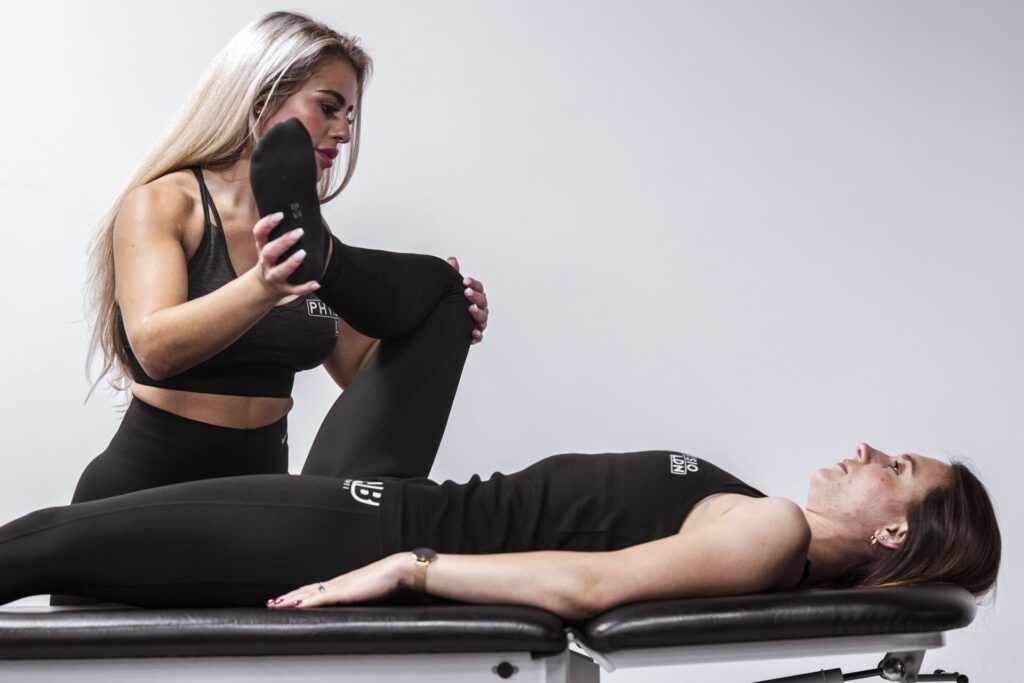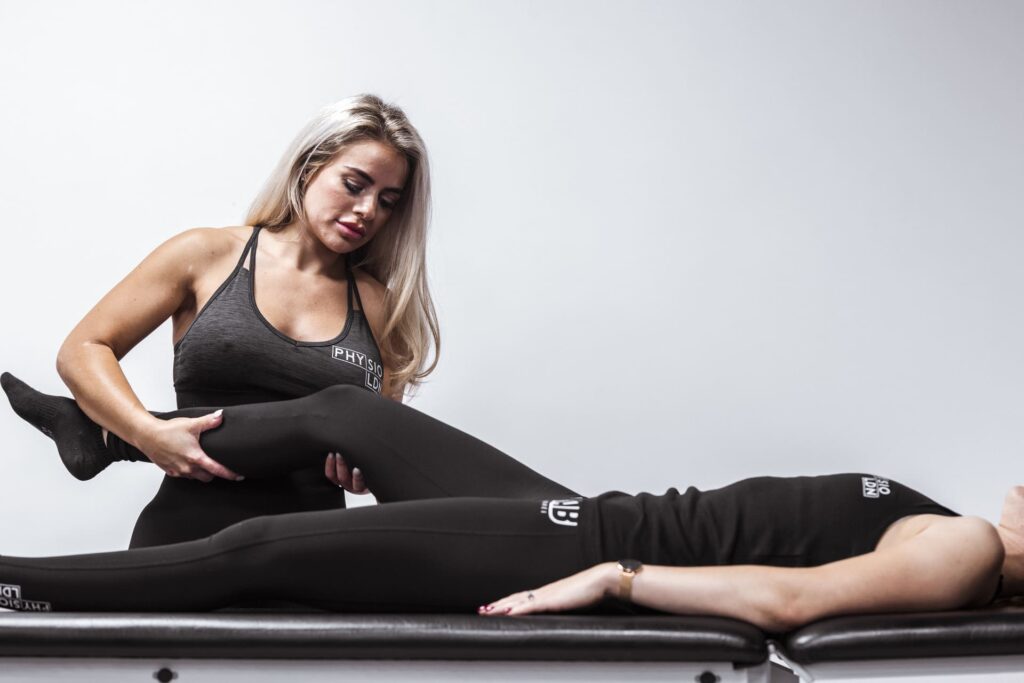Table of Contents
Main Takeaways
- Knee pain affects ~25% of adults; common causes include OA, PF pain syndrome, ligament/meniscal injuries, and bursitis.
- Good diagnosis = history, exam, and focused tests — identify pain onset, mechanism, red flags (swelling, locking, fever), and function loss.
- Key tests: Lachman (ACL), McMurray (meniscus), imaging (X-ray for OA/fracture; MRI for soft tissues), labs for infection/inflammation.
- New tools: AI-assisted X-ray analysis shows radiologist-level accuracy for early OA detection.
- Refer early for persistent pain, trauma, bilateral symptoms, or failed conservative care; physiotherapy accelerates recovery.
Knee pain is a common complaint affecting approximately 25% of adults, leading to nearly 4 million primary care visits annually in the UK alone. Understanding the underlying cause of knee pain is essential for effective treatment and recovery. The knee is a complex joint, and its pain can arise from a variety of conditions ranging from acute injuries to chronic degenerative diseases. This article explores how healthcare professionals differentiate among these conditions, the key tests involved, and when to seek specialist care. If you’re exploring local pathways, consider knee pain treatment in London.
How Doctors Differentiate Knee Conditions
Diagnosing the cause of knee pain begins with a detailed clinical history and physical examination. According to experts, “a good clinical history, assessment, and anatomical knowledge gives a strong foundation to narrow down the diagnosis” of knee pain. This approach helps to distinguish between the many potential causes, including ligament injuries, meniscal tears, patellofemoral pain syndrome, and osteoarthritis.

For example, patellofemoral pain syndrome, which has a lifetime prevalence of about 25%, typically affects younger, physically active individuals under 40 years of age. In contrast, knee osteoarthritis is more common in adults aged 45 and older and affects an estimated 654 million people worldwide, making it a leading cause of knee pain in this demographic.
Bilateral knee pain and lower educational levels have also been linked to persistent knee pain over time, emphasizing the importance of early and accurate diagnosis. For detail information see the blog knee pain diagnosis: tests, imaging & when to seek help.
Doctors use the patient’s history to identify factors such as the onset and duration of pain, any history of trauma, activity levels, and associated symptoms like swelling or locking. This information helps to prioritize potential diagnoses and guide further testing. The differential diagnosis of knee pain is extensive but can be narrowed with a detailed history, a focused physical examination, and, when indicated, the selective use of appropriate imaging and laboratory studies, as highlighted in Evaluation of Patients Presenting with Knee Pain: Part I.
In addition to the initial assessment, doctors may employ specific physical tests to evaluate the integrity of knee structures. For instance, the Lachman test is commonly used to assess the anterior cruciate ligament (ACL), while the McMurray test helps in identifying meniscal tears. These tests, combined with imaging techniques such as X-rays or MRIs, provide a clearer picture of the knee’s condition. Imaging can reveal not only bone abnormalities but also soft tissue injuries, which are crucial for formulating an effective treatment plan.
Furthermore, the role of patient education cannot be overstated in the management of knee conditions. Understanding the nature of their injury and the rationale behind recommended treatments empowers patients to take an active role in their recovery.
This may involve discussions about lifestyle modifications, rehabilitation exercises, and even dietary changes that can support joint health. By fostering a collaborative relationship between the patient and healthcare provider, the chances of successful outcomes and long-term relief from knee pain can significantly improve.
Key Tests
Once a preliminary diagnosis is suspected, healthcare providers employ various tests to confirm the cause of knee pain. Physical examination techniques include assessing joint stability, range of motion, and identifying tender points. Special tests for ligament integrity, such as the Lachman test for ACL injuries, and meniscal tests like McMurray’s test, are commonly used. Additionally, healthcare professionals may utilize the pivot shift test to evaluate the stability of the knee joint, particularly in cases where ACL injuries are suspected. This comprehensive approach ensures that all potential issues are thoroughly investigated, providing a clearer picture of the underlying problem.

Imaging plays a crucial role in diagnosis. X-rays are typically the first-line imaging modality to evaluate for osteoarthritis, fractures, or joint space narrowing. Recent advances in technology have introduced deep learning frameworks that analyze X-rays to detect early knee osteoarthritis with accuracy comparable to expert radiologists. For instance, a confidence-driven deep learning framework has shown promising results in early detection, as detailed in Confidence-Driven Deep Learning Framework for Early Detection of Knee Osteoarthritis. This innovative approach not only enhances diagnostic accuracy but also has the potential to streamline patient care by enabling earlier interventions and personalized specialist London knee pain physiotherapists treatment plans.
In more complex cases, MRI scans provide detailed images of soft tissues, including ligaments, cartilage, and menisci, helping to identify tears or inflammation. This imaging technique is particularly valuable because it offers a non-invasive way to visualize the intricate structures of the knee, allowing for a more accurate diagnosis of conditions like meniscal tears or cartilage degeneration.
Laboratory tests may be ordered if an infectious or inflammatory cause is suspected, such as septic arthritis or rheumatoid arthritis. These tests can include blood work to check for markers of inflammation or infection, and joint aspiration may be performed to analyze synovial fluid for signs of gout or other inflammatory conditions. By combining these various diagnostic methods, healthcare providers can develop a comprehensive understanding of the patient’s knee pain, leading to more effective treatment strategies.
When to Seek Specialist Care
While many cases of knee pain can be managed in primary care, certain scenarios warrant referral to specialists such as orthopedic surgeons or physiotherapists. Persistent knee pain lasting beyond 12 months, especially when associated with bilateral symptoms or lower educational levels, may indicate a chronic condition requiring specialist intervention. This can often be a sign of underlying issues such as osteoarthritis, which can progressively worsen if not addressed promptly. Patients should be vigilant about accompanying symptoms like swelling, instability, or a reduced range of motion, as these can further guide the need for specialist care. At this stage, booking with a professional knee pain physiotherapist can help coordinate next steps.

Early specialist assessment is particularly important following significant trauma, suspected ligament or meniscal injuries, or when conservative management fails to improve symptoms. In cases of acute injury, immediate evaluation can prevent further damage and facilitate a more effective treatment plan. Post-operative rehabilitation after surgeries like ACL reconstruction or knee replacement also demands expert physiotherapy to restore function and strength. The rehabilitation process is crucial, as it not only helps in regaining mobility but also in preventing complications such as stiffness or muscle atrophy, which can occur without proper guidance and support.
London residents seeking expert physiotherapy in London can benefit from clinics like One Body LDN, which offers award-winning musculoskeletal physiotherapy with a focus on personalized care. Their therapists receive over five times the required regulatory training and blend hands-on treatments with tailored exercise programs to ensure optimal recovery. This individualized approach is essential, as every patient’s needs and recovery timelines can differ significantly. Additionally, the clinic emphasizes the importance of patient education, empowering individuals to understand their conditions and actively participate in their recovery journey.
FAQ
What are the most common causes of knee pain?
The most common causes include osteoarthritis, patellofemoral pain syndrome, ligament injuries (such as ACL tears), meniscal injuries, and bursitis. Each condition has distinct features that help doctors differentiate among them. Osteoarthritis, for instance, is characterized by the degeneration of cartilage and often leads to stiffness and swelling, particularly after periods of inactivity. Patellofemoral pain syndrome, on the other hand, is frequently seen in athletes and is associated with pain around the kneecap, often exacerbated by activities like squatting or climbing stairs. Understanding these nuances is crucial for effective treatment and management.
How is knee osteoarthritis diagnosed?
Knee osteoarthritis is typically diagnosed through a combination of patient history, physical examination, and imaging such as X-rays. Recent advances in AI-assisted imaging analysis have improved early detection accuracy. Additionally, doctors may assess the range of motion and perform specific tests to evaluate the knee’s stability and functionality. In some cases, MRI scans may be utilized to provide a more detailed view of the cartilage and surrounding structures, helping to confirm the diagnosis and rule out other potential issues.
When should I see a physiotherapist for knee pain?
If knee pain persists beyond a few weeks, limits your daily activities, or follows an injury, consulting a physiotherapist can help. They can provide hands-on treatment and design rehabilitation exercises to promote recovery. Early intervention is particularly beneficial, as physiotherapists can assess movement patterns and identify any biomechanical issues contributing to the pain. They may also incorporate modalities such as ultrasound or electrical stimulation to alleviate pain and enhance healing, ensuring a comprehensive approach to recovery.
Can knee pain be prevented?
Maintaining a healthy weight, engaging in regular low-impact exercise, and avoiding activities that strain the knee excessively can help prevent knee pain. Proper warm-up and stretching before physical activity are also beneficial. Furthermore, incorporating strength training exercises that focus on the muscles surrounding the knee can provide additional support and stability. Activities like swimming and cycling are excellent choices, as they minimize impact while promoting joint health. Additionally, wearing appropriate footwear and using knee supports during high-impact sports can further reduce the risk of injury.
Is sports massage effective for knee pain?
Sports massage, particularly deep tissue massage, can relieve muscle tightness and improve joint mobility, aiding recovery from knee pain caused by muscular imbalances or overuse injuries. This type of massage focuses on deeper layers of muscle and connective tissue, which can help break down scar tissue and improve circulation. Moreover, regular sports massage can enhance athletic performance by promoting flexibility and reducing muscle soreness post-exercise. Many athletes find that integrating massage therapy into their training regimen not only helps with recovery but also serves as a preventive measure against future injuries.
How long does physiotherapy for knee pain usually take?
The duration varies depending on the condition’s severity and chronicity. Acute injuries may improve significantly within 4-6 sessions, while chronic conditions might require longer-term management. A personalized treatment plan is essential, as physiotherapists will adjust the frequency and intensity of sessions based on the patient’s progress. In some cases, patients may also be encouraged to continue specific exercises at home to reinforce gains made during therapy, ensuring a more effective recovery process.
Are private physiotherapy sessions better than NHS for knee pain?
Private physiotherapy often offers shorter waiting times and longer, more personalized sessions compared to NHS services, which can facilitate faster recovery. In private practice, physiotherapists may have more flexibility to tailor treatments to individual needs, incorporating a wider range of techniques and technologies. Furthermore, patients often appreciate the continuity of care, as they are more likely to see the same therapist throughout their treatment journey. This personalized approach can foster a stronger therapeutic relationship, enhancing motivation and adherence to rehabilitation protocols.
Start Your Journey to Knee Pain Relief with One Body LDN
If you’re struggling with knee pain, don’t wait for it to become a long-term issue. At One Body LDN, voted as the best London physio clinic, we’re dedicated to finding the root cause of your problem. Our expert team, including former athletes and NHS specialists, offers comprehensive assessments and personalized rehab plans to address your specific needs. From musculoskeletal physiotherapy to post-operative care and sports injuries, we provide award-winning treatments that blend exercise rehab with deep tissue massage. We accept a range of insurance providers, making your path to recovery seamless. Book your free initial assessment at our clinic today and experience instant pain relief with our results-based approach. Book your free initial assessment and let us help you feel amazing again.


